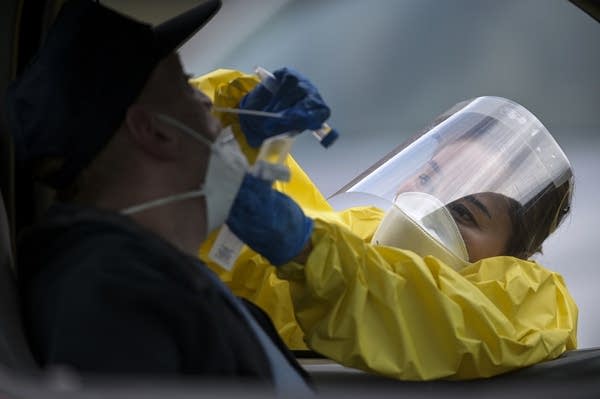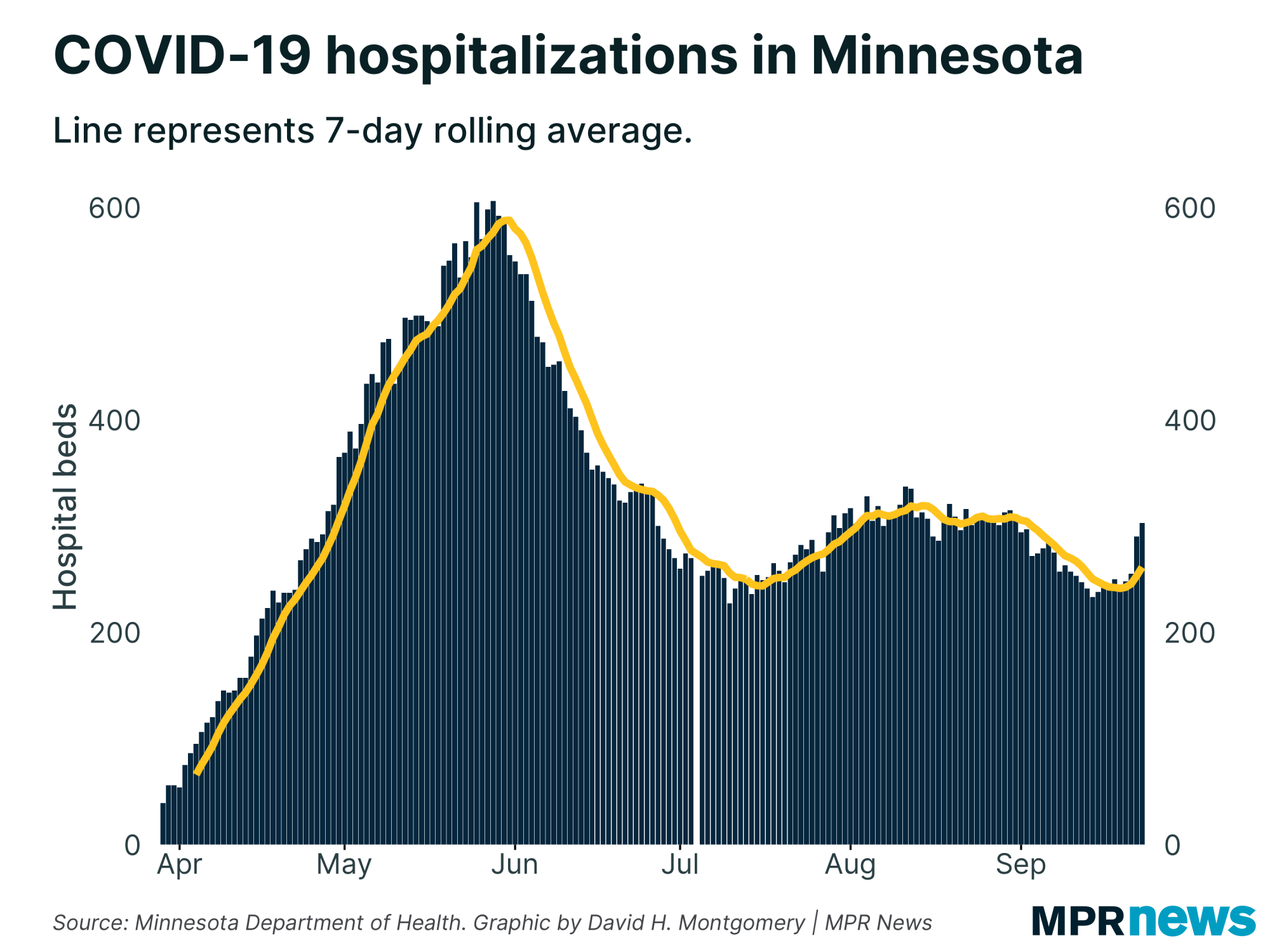Aug. 19 update on COVID-19 in MN: As deaths rise, a plea to 'do the right thing'

Go Deeper.
Create an account or log in to save stories.
Like this?
Thanks for liking this story! We have added it to a list of your favorite stories.
Updated: 4 p.m.
State health authorities on Wednesday pleaded with Minnesotans to do the right things to stem the spread of COVID-19 even as they expressed frustration over fresh reports of Minnesotans doing the wrong things.
For instance, officials are hearing anecdotal but “troubling reports” of parents who want their kids back in K-12 school buildings this fall so badly that they are choosing not to get their children tested for COVID-19, despite symptoms, for fear it will hurt their local school’s chances of teaching in-person, Dr. Ruth Lynfield, the state’s epidemiologist, said Wednesday.
“These behaviors are exactly the wrong thing to do if we want to get the COVID pandemic in Minnesota under control to the point where more in-person learning is possible,” she told reporters.
Without providing details, she said the Health Department has been told of “multiple parties” where the virus has been transmitted and reiterated concerns college students are gathering to party before the school year starts and that may deliver COVID-19 to campuses.
Turn Up Your Support
MPR News helps you turn down the noise and build shared understanding. Turn up your support for this public resource and keep trusted journalism accessible to all.
As she and her colleagues have done for months, Lynfield implored Minnesotans to wear masks in public indoor spaces, socially distance and stay away from large gatherings to stem the disease’s spread, even as she acknowledged the overall fatigue facing Minnesotans who want to return to life before the disease.
“The way out of this mess is clear,” Lynfield said. “Health care professionals and health care providers have their roles to play — and so does every single Minnesotan. We need people to do the right thing.”
‘Respect the virus’
Lynfield’s remarks came hours after the Health Department reported 17 additional deaths, the highest daily count in two months. Daily deaths have been mostly in single digits since late June. Officials did not have a specific explanation for Wednesday's results.

The state finds itself in a recent cycle of mostly moderate daily death counts but a stubbornly persistent level of hospitalizations. While the state may be at or just below the crest of the current wave, experts say more waves are coming.
“I really think people need to respect the virus, and I think people should be alarmed at the amount of community transmission we now have,” Lynfield said Wednesday.
The number of people currently hospitalized — a closely watched metric as officials work to manage the spread of the disease so it doesn’t overwhelm the health care system — rose to 321, up 17 from Tuesday, with 152 of those patients needing intensive care.
Current hospitalizations remain far below a late-May peak, but the count has flattened at a relatively high level — more than 300 daily cases on average during August.

Of the 66,618 total confirmed cases of the disease since the pandemic began, about 90 percent have recovered to the point where they no longer need to be isolated.
Among the 1,738 people confirmed to have died from the disease in Minnesota, about 75 percent had been living in long-term care or assisted living facilities.

The Health Department data Wednesday also contained some unusual numbers on testing, with the agency reporting nearly 35,000 new tests, dramatically higher than the number reported Tuesday.
The department explained the anomaly, saying a backlog of tests was loaded into its reporting system, adding that “the vast majority were negative tests that we received from several labs. Specimen dates go as far back as April.”
Southern Minnesota cases rising again
Regionally, the Twin Cities and its suburbs have been driving the counts of newly reported cases, although there’s an upswing now in southern Minnesota.

Northern Minnesota cases have been mostly on the rise since early July. Beltrami County, home to Bemidji, has seen a steady climb the past few weeks. The county reported 281 cases and one death as of Wednesday.
Meatpacking operations had been hot spots for big outbreaks in southwest, west-central and central Minnesota earlier in the pandemic.

New cases have slowed considerably in recent weeks, although the problem has resurfaced recently in McLeod County (279 cases), where more than 20 employees at a Seneca Foods plant in Glencoe were identified recently in an outbreak.
College concerns grow as fall semester nears
Worries continue about the growth of COVID-19 among younger Minnesotans, including that those infected will inadvertently spread the virus to grandparents and other more vulnerable people.

People in their 20s remain the age group with the highest number of COVID-19 confirmed cases in the pandemic — more than 15,000. The median age of cases is 36.
State public health leaders are increasingly worried about college students joining end-of-summer parties and other gatherings that could feed the spread of COVID-19 and bring it onto campuses this fall.
Clusters of cases surfaced in late June around college bars, including in Mankato, Minneapolis and St. Cloud. Concerns over similar potential outbreaks are percolating again as the fall semester nears.
The Health Department this week posted additional guidance to colleges on ways to reduce COVID-19 risk.
Officials are asking students to self-isolate for two weeks before returning to campus, noting that the University of North Carolina, Notre Dame and Michigan State have been forced to retreat from their plans to teach in-person this fall amid campus outbreaks.
While colleges are working hard now to make their schools as safe as possible against the disease, Lynfield on Wednesday called on students to take personal responsibility.
“We’re not going to be able to test our way out of this pandemic,” she said. “Having a negative test doesn’t mean you now have a green light to go and socialize and not to keep the distance. We’re very concerned about the kind of messages — ‘Well, you can just keep testing and people can use their BC, before COVID, behavior.’ We have to work together.”
Developments from around the state
Sartell HealthPartners clinic closing will cost about 100 jobs
A central Minnesota medical clinic is set to lay off about 100 workers as it prepares to close its doors.
The St. Cloud Times reported Wednesday that the Sartell, Minn., HealthPartners clinic will close permanently this month. The HealthPartners’ dental clinic in the building will remain open, however.
Company officials say the clinic closure will result in about 100 layoffs. They say those workers are being encouraged to apply for other positions within the company.
HealthPartners announced in July that it would close seven clinics and two specialty centers in Minnesota, including the facility in Sartell. HealthPartners spokesperson Vince Rivard said then that the COVID-19 pandemic has forced the organization to rethink how they can meet patient needs in new ways such as video visits and fewer physical sites will help reduce costs.
— The Associated Press
Remote classes, single dorm rooms: Macalester lays out fall plan
Macalester College is preparing to welcome first-year students to campus next week. The president of Macalester College says the school has instituted a number of precautions to prevent COVID-19 infections and transmissions among students who begin arriving next week.
President Suzanne Rivera said the first two weeks of instruction will be held remotely. And students will have the option to continue that type of learning as the semester continues, she said.
"This is making education more democratic. It's more inclusive. It's more responsive to people who have different learning styles,” said Rivera. “So, I actually hope that we retain a lot of these behaviors and these new tools that we've put in our toolboxes because it will make education better."
She said other precautions include single-occupancy dorm rooms and the use of video conference technology for both curricular and extracurricular activities. The school won't be able to accommodate all students at once, the president said.
Rivera said Macalester is renting hotel rooms in order to accommodate the introduction of more students to campus in October.
— Brandt Williams | MPR News
School guidance map shifts with new data
Fresh data released by the Minnesota Department of Health is again shifting the guidance for some of the state’s school districts as they decide whether to teach kids in-person, online or in some combination based on their local COVID-19 conditions.
The new numbers, for instance, indicate elementary school students in Ramsey and Dakota counties would no longer be recommended to attend school in person — if school started this week — due to rising COVID-19 cases.
Data released Thursday by the Health Department indicate 11 counties, including Ramsey and Dakota, should shift away from in-person learning because of rising cases.

Schools in another 14 counties, largely in the southern part of the state, would be recommended to shift toward in-person learning. The state’s other 62 counties saw no change in their recommendations, which are based on COVID-19 cases per capita over a 14-day period.
Officials have emphasized the map is meant to be a starting point for school districts as they weigh their mix of in-person and online instruction in the COVID-19 era. The numbers, and the accompanying recommendations, are updated every week now.
Counties with very few cases per capita are recommended to have in-person learning for all students — 48 counties as of Thursday.
With more cases, schools are urged to have secondary students do a mix of in-person and distance learning while still doing in-person school for elementary grades. Another 29 counties fall into that category.
Eight counties are currently recommended for hybrid learning for all students. They include Hennepin, Ramsey, Dakota, Scott, Sherburne and Blue Earth.
Two counties have so many cases that the state currently recommends upper-grade students there study remotely full-time: Rock County in southwestern Minnesota, and Red Lake County in northwestern Minnesota.
Officials have stressed that the county-level data is a roadmap, not an order. Districts within those counties are making decisions that may not fit exactly with the data.
St. Paul Public Schools, the state’s second largest school district and the largest district in Ramsey County, has already announced it will start the school year with all students distance learning and will revisit the decision in late September.
— David H. Montgomery | MPR News
Top headlines
CDC report shows pandemic fuels threefold increase in rates of depression, anxiety: A report out this week from the U.S. Centers for Disease Control and Prevention says nearly 41 percent of adults reported adverse mental health conditions in June, with those reporting depression and anxiety up threefold from the same time last year. Dr. Jon Hallberg says anyone who needs help shouldn’t let the pandemic keep them from seeking it.
COVID-19 case confirmed at Sturgis bar: South Dakota health officials on Tuesday warned that one person who spent several hours at a bar on Main Street in Sturgis during last week’s massive motorcycle rally has tested positive for COVID-19 and may have spread it to others.
COVID-19 in Minnesota
Data in these graphs are based off Minnesota Department of Health cumulative totals released at 11 a.m. daily. You can find more detailed statistics on COVID-19 at the Health Department website.
The coronavirus is transmitted through respiratory droplets, coughs and sneezes, similar to the way the flu can spread.


